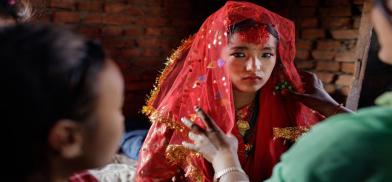More child marriages in locked down Nepal
Million of girls continue to be subjected to child marriage and other harmful practices against women including sex-selective abortion across the world, and the rate may go up during the COVID-19 pandemic, says the UNFPA State of World Population 2020 report released on Tuesday

Million of girls continue to be subjected to child marriage and other harmful practices against women including sex-selective abortion across the world, and the rate may go up during the COVID-19 pandemic, says the UNFPA State of World Population 2020 report released on Tuesday.
Nepal has one of the highest rates of child marriage in Asia. The legal age of marriage for both sexes is 20, yet some 40% of Nepali girls are married before the age of 18. While child marriage rates are declining in the country, in the last five years the pace of decline has slowed down significantly.
Similarly, traditional son preference over daughters continue to persist in the Nepali society. Every year thousands of women from western Nepal alone make trips to Nepalganj or across the border for sex-selective abortion. As a result Nepal has an increasing sex ratio at birth imbalance from 103 male per every 100 female newborns in 2005 to 110 male newborns in 2015.
“Harmful practices against girls cause profound and lasting trauma, robbing them of their right to reach their full potential,” says Executive Director of the UN’s Population Fund Natalia Kanem. “We must tackle the problem by tackling the root causes, especially gender-biased norms. We must do a better job of supporting communities’ own efforts to understand the toll these practices are taking on girls and the benefits that accrue to the whole of society by stopping them.”
Nepal has ratified international treaties such as the Convention on the Rights of the Child, thus is duty-bound to end the harms inflicted on girls. Nepal does have progressive laws in place, but they have not been sufficient to bring about the change. Restructuring legal systems that support girls such as property rights could provide incentive to eliminate gender-based discrimination.
The UNFPA report says that ending child marriage is possible within 10 years by scaling up efforts to keep girls in school longer and teach them life skills and to engage men and boys in social change. Indeed, Nepal has made dramatic progress in female literacy by reducing high girl child dropout rates with grassroots awareness, education and hygiene practices.
But experts now fear that the COVID-19 pandemic will reverse the previous gains. A recent analysis quoted in the UNFPA report revealed that if services and programs remain shuttered for six months, an additional 13 million girls around the world may be forced into marriage between now and 2030.
In fact, organisations working in female literacy such has the advocacy group Room to Read have actually reported a sharp rise in child marriages and trafficking of girls in Nepal’s Tarai districts during the lockdown.
Adds Kanem of the United Nations sexual and reproductive health agency: “The pandemic both makes our job harder and more urgent as so many more girls are now at risk. We will not stop until the rights, choices and bodies of all girls are fully their own.”
https://www.nepalitimes.com/latest/more-child-marriages-in-locked-down-nepal/









Post a Comment